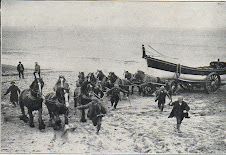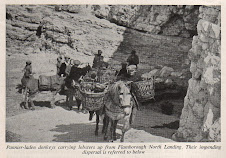“Horseworld misses bridleway and coastal access chances”
Horse and Hound 11th June 2009.
This unhelpful and misleading article about coastal access for equestrians seems to imply that the hard working people involved in improving our countryside access have not done enough.
This is simply not true. Baroness Mallalieu, Lord Greaves and Lord Taylor were extremely well briefed by the BHS and the National Federation of Bridleways Associations. They put the case to the Lords for the need to protect our existing access, and the inclusion of equestrians to the coastal margin with great cogency. The amendments which have been made to the Bill as a result of their support do at least represent some progress for horse riders.
Before jumping in to criticise, Horse and Hound would do well to recognise what the equestrian access lobby is actually up against and lend them their support.
Government policy that the scope of the Coastal Access would only apply to walkers, was set in stone as early as 2005 and predated the consultation period. The Minister with responsibility for that decision was Jim Knight, the then Minister for the Horse. What this important sounding post actually entails, is a mystery. Certainly not acting as a champion for equestrian access.
In 2007 a research paper commissioned by Defra was published, the Asken Report into Coastal Access. The Report noted the popularity of horse riding on many beaches around the country. It wisely alerted government to the possible disadvantage to equestrian access of promoting a statutory access on foot only.
As a way of limiting that damage the report recommended that ‘the opportunity could be taken to extend access rights for horses to foreshores and beaches, thereby making a wider range of such areas available for horse riding.’ The report was considered (presumably in some detail) by the Secretary of State for Environment Food and Rural Affairs, the then Minister for the Horse Minster Barry Gardiner.
The British Horse Society and the Equestrian Access Forum were in correspondence with Barry Gardiner at that time but still no action was taken to either protect existing equestrian access or to improve it. Lobbying a government which is not prepared to even listen to your concerns is not a rewarding experience but at least the consultation period would offer the equestrian community a chance to have their say.
Of the 35 respondents to the consultation question, whether higher rights should be included, 27 were in favour and only 9 were against. Unfortunately, even this pronounced majority in favour of the inclusion of higher rights was not enough to change the government’s mind. The unchanged Bill rolled on to the Select Committee.
Since the Coastal Access provisions put before the Select Committee excluded horse riders, no representative from the equestrian access lobby was invited to appear. The discussions were almost entirely limited to the concerns of the Ramblers Association and the Country Landowners Association.
However, written evidence from other groups was made available to the Committee. The 19 respondents in favour of including horse riders were characteristically Local Authorities, Local Access Forums and representatives of charitable organisations with an interest in promoting countryside access. 7 of those expressed concern that Natural England had not recognized existing traditional recreational use. Evidence was also received from the four Coastal Access pilot study areas, three of these recommended that horse riders should be included.
Pieces of written evidence against the inclusion of horse riders were slightly fewer, 16 in all. These were mainly from landowners, occupiers or their advisory bodies. The striking point about these responses was that it was not always clear to whether they were referring to the coastal paths, the coastal margin or the foreshore. Only 2 out of a total of 16 respondents against were specifically concerned about horse riders’ current use of the foreshore. Which flags up the fact that amending the Bill to include statutory access to that area, would probably be a popular measure.
So, Amendment 124T, obtained in the House of Lords, which aims to preserve our existing access to the foreshores, was really quite an achievement in the face of such determined opposition from government. That was the first opportunity horse riders have had to express their concerns, which government has done its utmost to suppress.
There is still work to do though. The amendment is worded in very general terms (see below) and the fact that the Bill does not specifically recognize horse riders as legitimate existing users, is a serious omission which needs to be challenged in the House of Commons. It would be most encouraging if Horse and Hound supported this measure.
124T: Clause 293, page 188, line 37, at end insert—
“( ) In section 20 (codes of conduct and other information)—
(a) in subsection (1), omit “and” at the end of paragraph (a) and after paragraph (b) insert
“, and (c) that, in relation to access land which is coastal margin, the public are informed that the right conferred by section 2(1) does not affect any other right of access that may exist in relation to that land.”,
Whereas the amendment tabled by Lord Greaves and Lord Tyler but subsequently withdrawn was more strongly worded:
propose that the CROW Act Schedule 2 be amended by inserting at the end of paragraph 1c, “or in the case of that part of the Coastal Margin land which is foreshore, a dog or a horse.”
skip to main |
skip to sidebar


Bringing in the Lifeboat

Statutory Access to the Foreshore...
News
Traditional Access
Donkey panniers Flamborough North Landing 1952

Access in Scotland
Sharp Practice
Legislation ignores us once again....
A flawed consultation…..
Environmental concerns.....
No thank you Natural England…..
Over the Stable Door
About Me
Blog Archive
-
▼
2009
(16)
- ► 01/04 - 01/11 (4)
- ► 01/11 - 01/18 (1)
- ► 03/15 - 03/22 (1)
- ► 03/22 - 03/29 (2)
- ► 03/29 - 04/05 (1)
- ► 06/14 - 06/21 (1)
- ▼ 06/21 - 06/28 (4)
- ► 07/05 - 07/12 (1)
- ► 11/08 - 11/15 (1)